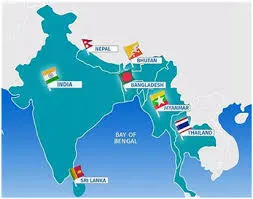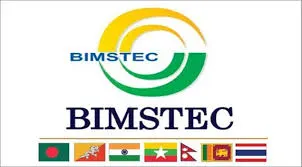BIMSTEC (Bay of Bengal Initiative for Multi-Sectoral Technical and Economic Cooperation) fosters regional ties among South and Southeast Asian nations to boost economic growth, trade, and development.
What is BIMSTEC? A Regional Cooperation Platform
The Bay of Bengal Initiative for Multi-Sectoral Technical and Economic Cooperation (BIMSTEC) is an important regional organization aimed at fostering economic, technical, and cultural cooperation among countries in South Asia and Southeast Asia. Established in 1997, BIMSTEC brings together seven countries—India, Bangladesh, Myanmar, Sri Lanka, Thailand, Bhutan, and Nepal—that share the Bay of Bengal as a common maritime space.
With its strategic location, BIMSTEC serves as a platform for cooperation in various sectors, such as trade, connectivity, climate change, and disaster management. The initiative aims to harness the collective potential of the region to address common challenges and enhance socio-economic growth.

BIMSTEC’s Strategic Importance
BIMSTEC represents a bridge between South Asia and Southeast Asia, making it a crucial player in the region’s geopolitical landscape. The organization is unique because it blends countries with diverse economic backgrounds, cultures, and political systems. This diversity, however, creates a powerful synergy that allows for multi-faceted cooperation.
The Bay of Bengal itself is a vital maritime route for trade, connecting major economies such as India, Bangladesh, and Thailand. BIMSTEC’s formation was driven by the desire to ensure the region’s sustainable economic development, considering its geographic advantages and strategic significance.
Key Areas of Cooperation in BIMSTEC
1. Economic and Trade Integration
Economic cooperation is one of the primary pillars of BIMSTEC. The member countries work to enhance intra-regional trade by reducing trade barriers, improving connectivity, and creating a common economic platform for growth. In recent years, BIMSTEC has focused on trade agreements and regional economic integration to build a more robust market for the member countries.
By promoting trade, the organization aims to enhance the collective economic output and improve livelihoods for people across the region. The increased economic interdependence among BIMSTEC countries can also pave the way for a more secure and prosperous region.
2. Infrastructure Development and Connectivity
Another key area of focus for BIMSTEC is improving infrastructure and connectivity. The region is geographically diverse, with the Bay of Bengal as a central feature. Improved transport networks, ports, and air links can help unlock the potential of this maritime space for trade, tourism, and economic cooperation.
Projects such as the Bangladesh, India, Myanmar, Thailand (BIMT) highway have the potential to create better land connectivity, which in turn would reduce transportation costs and boost trade. Investment in modern infrastructure could also be a catalyst for boosting economic growth and improving the region’s overall competitiveness.
3. Environmental Sustainability and Disaster Management
Given the vulnerability of the Bay of Bengal region to natural disasters like cyclones, floods, and tsunamis, environmental sustainability is a critical issue for BIMSTEC. The member states work together to address climate change challenges, share knowledge, and implement disaster management strategies.
BIMSTEC’s collaboration on environmental matters extends to sustainable development practices, resource management, and creating disaster preparedness frameworks. This cooperation is vital in mitigating the effects of climate change, ensuring that the region remains resilient to natural disasters, and protecting its rich marine and coastal ecosystems.
4. Security and Counter-Terrorism
Regional security is another core concern of BIMSTEC. The organization focuses on combating terrorism, organized crime, and human trafficking. As member countries face common security challenges, they coordinate efforts to tackle these threats through joint initiatives and information-sharing.
BIMSTEC’s approach to security emphasizes both the prevention of security threats and the promotion of peace and stability in the region. In this context, the initiative contributes to broader regional and international peacekeeping efforts.

The Future of BIMSTEC: Challenges and Opportunities
While BIMSTEC has achieved considerable success in promoting regional cooperation, challenges remain. Political differences, differing priorities among member states, and infrastructural limitations can sometimes impede progress. Furthermore, the broader geopolitical landscape in Asia, including the rise of China and competing regional organizations like ASEAN, presents both opportunities and challenges for BIMSTEC’s future.
However, BIMSTEC’s ability to bring together countries with shared economic and environmental concerns presents a significant opportunity for enhanced collaboration. As global trade flows shift and regional dynamics evolve, BIMSTEC’s role in driving collective growth and sustainability in the Bay of Bengal region could become more pronounced.
Conclusion
BIMSTEC represents an essential platform for enhancing regional cooperation in South and Southeast Asia. By focusing on trade, connectivity, security, and environmental sustainability, the organization is positioning itself to play a central role in shaping the future of the Bay of Bengal region. With growing collaboration and continued focus on mutual benefits, BIMSTEC has the potential to create a prosperous and stable future for its member states.





